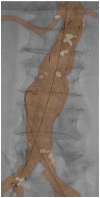Endovascular Aneurysm Repair for Abdominal Aortic Aneurysm: A Comprehensive Review
- PMID: 31339013
- PMCID: PMC6658877
- DOI: 10.3348/kjr.2018.0927
Endovascular Aneurysm Repair for Abdominal Aortic Aneurysm: A Comprehensive Review
Abstract
Abdominal aortic aneurysm (AAA) can be defined as an abnormal, progressive dilatation of the abdominal aorta, carrying a substantial risk for fatal aneurysmal rupture. Endovascular aneurysmal repair (EVAR) for AAA is a minimally invasive endovascular procedure that involves the placement of a bifurcated or tubular stent-graft over the AAA to exclude the aneurysm from arterial circulation. In contrast to open surgical repair, EVAR only requires a stab incision, shorter procedure time, and early recovery. Although EVAR seems to be an attractive solution with many advantages for AAA repair, there are detailed requirements and many important aspects should be understood before the procedure. In this comprehensive review, fundamental information regarding AAA and EVAR is presented.
Keywords: Abdominal aortic aneurysm; Endovascular aneurysmal repair; Stent-graft.
Copyright © 2019 The Korean Society of Radiology.
Conflict of interest statement
The authors have no potential conflicts of interest to disclose.
Figures





















References
-
- Kuivaniemi H, Elmore JR. Opportunities in abdominal aortic aneurysm research: epidemiology, genetics, and pathophysiology. Ann Vasc Surg. 2012;26:862–870. - PubMed
-
- Lederle FA, Johnson GR, Wilson SE, Ballard DJ, Jordan WD, Jr, Blebea J, et al. Veterans Affairs Cooperative Study #417 Investigators. Rupture rate of large abdominal aortic aneurysms in patients refusing or unfit for elective repair. JAMA. 2002;287:2968–2972. - PubMed
-
- Parodi JC, Palmaz JC, Barone HD. Transfemoral intraluminal graft implantation for abdominal aortic aneurysms. Ann Vasc Surg. 1991;5:491–499. - PubMed
Publication types
MeSH terms
LinkOut - more resources
Full Text Sources

